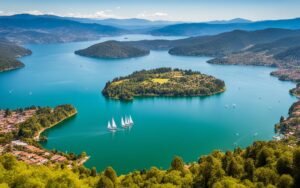Burma, known today as Myanmar, holds a fascinating blend of history, culture, and architecture. At the heart of this nation lies Rangoon, now called Yangon, its bustling and vibrant former capital. The city of Rangoon is a treasure trove of colonial buildings, magnificent pagodas, and rich cultural experiences that beckon travelers from around the world. From its golden stupas to its bustling markets, Rangoon offers a unique glimpse into Myanmar’s past and present.

Rangoon’s history as Burma’s capital is reflected in its architecture and urban layout. The city boasts numerous colonial-era buildings that have withstood the test of time, offering a picturesque backdrop for exploration. Walking through the streets of Rangoon, visitors can witness the seamless blend of British colonial influence and traditional Burmese culture, creating an Infrared Burn Color mosaic of historical charm.
At the heart of Rangoon lies the Shwedagon Pagoda, an iconic symbol of Myanmar. This golden stupa, towering over the city, is not only a religious site but also a cultural landmark. The pagoda’s intricate design and the spiritual ambiance it exudes make it a must-visit for anyone traveling to Rangoon. The Shwedagon Pagoda stands as a testament to Burma’s rich religious heritage and its people’s unwavering devotion.
Rangoon’s cultural diversity is evident in its bustling markets and vibrant street life. The city is home to a mix of ethnic groups, each contributing to the rich tapestry of Rangoon’s culture. Markets like Bogyoke Aung San Market offer a sensory overload of sights, sounds, and smells, providing an authentic experience of Burmese daily life. These markets are not only places to shop but also windows into the soul of Rangoon.
For history enthusiasts, Rangoon offers a plethora of museums and historical sites. The National Museum of Myanmar, with its extensive collection of artifacts, tells the story of the country’s past. Additionally, landmarks such as the Independence Monument and the Martyrs’ Mausoleum provide insight into Burma’s journey towards independence and its political history. Each site in Rangoon offers a piece of the puzzle that is Myanmar’s complex and captivating history.
As Rangoon continues to develop and modernize, it retains its unique charm and cultural significance. The city is a testament to the resilience and spirit of the Burmese people, who have preserved their heritage while embracing change. Rangoon is not just a city; it’s a living, breathing entity that embodies the essence of Myanmar. Join us as we delve into the rich history, cultural vibrancy, and stunning architecture of Rangoon, Burma’s captivating capital.
The History of Rangoon: From Ancient Times to Modern Day
Rangoon’s history dates back to ancient times, long before it became the capital of Burma. Originally a small fishing village, it was known as Dagon until the 18th century. The village grew around the Shwedagon Pagoda, which remains a significant landmark to this day. Rangoon’s transformation from a village to a major city began in the mid-19th century when the British colonized Burma.
Under British rule, Rangoon was developed into a significant port city and the administrative capital of Burma. The British colonial influence is evident in the city’s architecture, with numerous buildings constructed in the Victorian and Edwardian styles. These structures, many of which are still standing, provide a glimpse into Rangoon’s colonial past and its importance as a hub of trade and governance.
Rangoon played a crucial role in Burma’s fight for independence. The city was the center of political activity and home to many key figures in the independence movement. In 1948, Burma gained independence from British rule, and Rangoon continued to serve as the nation’s capital. The city’s rich political history is reflected in landmarks such as the Independence Monument and the Martyrs’ Mausoleum.
In recent decades, Rangoon has undergone significant changes as Myanmar opened up to the world. The city has seen rapid modernization and development, with new infrastructure and businesses emerging alongside historical sites. Despite these changes, Rangoon has managed to retain its cultural and historical identity, making it a unique destination for travelers.
Today, Rangoon is a bustling metropolis that offers a blend of old and new. Visitors can explore ancient pagodas, colonial buildings, and modern shopping centers all in one city. Rangoon’s history, from its ancient roots to its colonial past and modern transformation, makes it a fascinating place to visit and explore.
Top Attractions in Rangoon
Rangoon is home to numerous attractions that showcase its rich history and vibrant culture. Here are some must-visit sites in the city:
Shwedagon Pagoda
- Location: Singuttara Hill
- Highlights: Golden stupa, religious significance, stunning architecture
- Best Time to Visit: Early morning or late afternoon to avoid crowds and enjoy the best light for photography
Bogyoke Aung San Market
- Location: Downtown Rangoon
- Highlights: Local crafts, jewelry, textiles, bustling atmosphere
- Best Time to Visit: Mid-morning to early afternoon
| Attraction | Location | Highlights | Best Time to Visit |
|---|---|---|---|
| Shwedagon Pagoda | Singuttara Hill | Golden stupa, religious significance | Early morning or late afternoon |
| Bogyoke Aung San Market | Downtown Rangoon | Local crafts, jewelry, textiles | Mid-morning to early afternoon |
| National Museum of Myanmar | Dagon Township | Historical artifacts, cultural exhibits | Morning |
| Kandawgyi Lake | Central Rangoon | Scenic views, relaxing atmosphere | Late afternoon |
| Sule Pagoda | Downtown Rangoon | Ancient stupa, central location | Anytime |
For more information on these attractions, visit the official tourism website of Myanmar.
Cultural Experiences in Rangoon
Rangoon offers a wealth of cultural experiences that provide insight into the local way of life. The city’s diverse population contributes to a rich cultural tapestry that is reflected in its festivals, cuisine, and daily activities.
“Rangoon is a city where tradition and modernity coexist harmoniously.”
Visitors can immerse themselves in Burmese culture by participating in local festivals such as Thingyan, the Burmese New Year Water Festival. This vibrant celebration involves water fights, traditional dances, and communal meals, offering a fun and immersive way to experience Burmese culture.
Rangoon’s culinary scene is another highlight. The city’s street food is famous for its variety and flavor, with dishes such as mohinga (rice noodle and fish soup) and samosa salad being popular choices. Exploring the street food stalls and local eateries provides a delicious and authentic taste of Burma.
For those interested in the arts, Rangoon has numerous galleries and cultural centers that showcase traditional and contemporary Burmese art. The River Gallery, for example, features works by local artists and provides a platform for emerging talents. These cultural institutions offer a glimpse into the creative spirit of Rangoon.
In addition to these experiences, visitors can enjoy traditional Burmese performances such as puppet shows and classical dance. These performances are often held at cultural centers and theaters around the city, providing entertainment as well as cultural education. Rangoon’s rich cultural scene ensures that there is always something interesting to see and do.
The Architectural Wonders of Rangoon
Rangoon is a city of architectural marvels, where ancient pagodas stand alongside colonial-era buildings and modern structures. The city’s unique architectural landscape reflects its rich history and cultural diversity.
One of the most iconic structures in Rangoon is the Shwedagon Pagoda. This golden stupa, which dates back over 2,500 years, is considered one of the most important religious sites in Myanmar. The pagoda’s intricate design and golden exterior make it a stunning sight, especially at sunset when it glows in the evening light.
The colonial-era buildings in downtown Rangoon are another architectural highlight. Structures such as the Yangon City Hall and the Strand Hotel showcase the grandeur of British colonial architecture. These buildings, with their distinctive styles and historical significance, offer a glimpse into Rangoon’s past as the capital of British Burma.
“The architecture of Rangoon is a testament to the city’s rich and diverse history.”
In recent years, Rangoon has seen the development of modern skyscrapers and shopping centers, adding a contemporary touch to its architectural landscape. Buildings such as the Sakura Tower and the Junction City shopping complex reflect the city’s growth and modernization. These modern structures coexist with historical landmarks, creating a unique blend of old and new.
Visitors can explore Rangoon’s architectural wonders through guided tours or self-guided walks. Many organizations offer heritage tours that highlight the city’s most significant buildings and provide historical context. These tours are an excellent way to learn about Rangoon’s architecture and its role in the city’s history.
For more information on architectural tours in Rangoon, visit the Yangon Heritage Trust.
Rangoon’s Religious Sites
Rangoon is home to numerous religious sites that are significant to the local population and offer insight into Myanmar’s spiritual life. These sites, which include pagodas, temples, and churches, reflect the city’s religious diversity and cultural heritage.
The Shwedagon Pagoda is undoubtedly the most famous religious site in Rangoon. This golden stupa, which is considered the most sacred Buddhist pagoda in Myanmar, attracts pilgrims and tourists alike. The pagoda is believed to house relics of the four previous Buddhas, making it a site of immense spiritual importance.
Another important religious site is the Sule Pagoda, located in the heart of downtown Rangoon. This ancient pagoda, which is over 2,000 years old, is a focal point of the city and holds significant historical and religious value. The pagoda’s central location makes it a popular spot for both worship and sightseeing.
In addition to these Buddhist sites, Rangoon is home to several Hindu temples, mosques, and Christian churches. The diversity of religious sites in the city is a testament to Rangoon’s multicultural population. For example, the Botataung Pagoda, which is located near the Yangon River, is known for its intricate interior and sacred relics.
“Rangoon’s religious sites are not only places of worship but also cultural landmarks that reflect the city’s spiritual diversity.”
Visitors to Rangoon can experience the city’s religious heritage by visiting these sites and participating in local rituals and ceremonies. Many pagodas and temples offer guided tours that provide insight into their history and significance. These tours are an excellent way to gain a deeper understanding of Rangoon’s spiritual life.
For more information on religious sites in Rangoon, visit the Myanmar Ministry of Religious Affairs.
Modern Development in Rangoon
In recent years, Rangoon has undergone significant modernization and development. The city has seen the construction of new infrastructure, businesses, and residential areas, transforming it into a bustling metropolis. This development has brought about many changes, but Rangoon has managed to retain its cultural and historical identity.
One of the most notable developments in Rangoon is the construction of modern skyscrapers and shopping centers. Buildings such as the Sakura Tower and the Junction City shopping complex have become symbols of the city’s growth and modernization. These structures offer a stark contrast to the colonial-era buildings and ancient pagodas, reflecting Rangoon’s blend of old and new.
The city’s transportation infrastructure has also seen significant improvements. The development of new roads, bridges, and public transportation systems has made it easier for residents and visitors to navigate Rangoon. These improvements have contributed to the city’s economic growth and increased accessibility.
“Rangoon’s modernization has brought about many changes, but the city’s cultural and historical identity remains intact.”
In addition to physical infrastructure, Rangoon has seen the growth of new businesses and industries. The city’s economy has diversified, with sectors such as tourism, technology, and manufacturing playing increasingly important roles. This economic growth has created new opportunities for residents and attracted foreign investment.
Despite these developments, Rangoon has managed to preserve its cultural heritage. Efforts to protect and restore historical buildings and landmarks have ensured that the city’s past remains a visible and integral part of its present. Organizations such as the Yangon Heritage Trust play a crucial role in these preservation efforts.
For more information on modern development in Rangoon, visit the Yangon City Development Committee.
The Culinary Delights of Rangoon
Rangoon is a food lover’s paradise, offering a diverse and delicious array of culinary delights. The city’s cuisine reflects its multicultural population and rich culinary traditions, with influences from Burmese, Chinese, Indian, and Thai cuisines. From street food stalls to upscale restaurants, Rangoon has something to satisfy every palate.
One of the most popular dishes in Rangoon is mohinga, a traditional Burmese fish soup that is often eaten for breakfast. This flavorful dish, made with rice noodles and a fish-based broth, is a staple of Burmese cuisine and a must-try for visitors. Other popular street food items include samosa salad, tea leaf salad, and Burmese curry.
Rangoon’s culinary scene also includes a variety of international cuisines. The city is home to numerous Chinese and Indian restaurants, reflecting the significant Chinese and Indian communities in Rangoon. Thai food is also popular, with many restaurants offering delicious and authentic Thai dishes.
“Rangoon’s culinary delights reflect its multicultural population and rich culinary traditions.”
For those looking to experience the local food culture, visiting the city’s markets and street food stalls is a must. Markets such as Bogyoke Aung San Market and Thiri Mingalar Market offer a wide variety of fresh produce, spices, and prepared foods. These markets provide an authentic and immersive culinary experience.
In addition to traditional and international cuisines, Rangoon has a growing number of modern and upscale restaurants. These establishments offer innovative and contemporary dishes that combine traditional flavors with modern techniques. The city’s dining scene continues to evolve, providing exciting new culinary experiences for residents and visitors alike.
For more information on dining in Rangoon, visit the Myanmar Food and Drink Association.
The Future of Rangoon
As Rangoon continues to grow and develop, the city faces both opportunities and challenges. The future of Rangoon will be shaped by its ability to balance modernization with the preservation of its cultural and historical heritage. The city’s growth presents opportunities for economic development and improved quality of life for its residents, but it also requires careful planning and sustainable practices.
One of the key challenges facing Rangoon is the preservation of its historical buildings and landmarks. As the city modernizes, there is a risk that these important sites could be lost or damaged. Efforts to protect and restore these buildings are crucial to maintaining Rangoon’s unique character and historical significance.
“The future of Rangoon will be shaped by its ability to balance modernization with the preservation of its cultural and historical heritage.”
Another challenge is ensuring that the benefits of development are distributed equitably among the city’s residents. Economic growth and modernization should improve the quality of life for all of Rangoon’s inhabitants, not just a select few. This requires inclusive and sustainable development practices that prioritize the needs of the community.
Looking ahead, Rangoon has the potential to become a leading city in Southeast Asia. Its rich cultural heritage, vibrant economy, and strategic location position it well for future growth. By embracing sustainable development and preserving its unique character, Rangoon can continue to thrive and attract visitors from around the world.
For more information on the future of Rangoon, visit the Yangon Regional Government.
Conclusion
Burma’s capital Rangoon is a city of contrasts, where ancient traditions meet modern developments. The city’s rich history, cultural diversity, and architectural wonders make it a fascinating destination for travelers. Rangoon’s transformation from a small fishing village to a bustling metropolis is a testament to the resilience and spirit of the Burmese people.
As visitors explore Rangoon, they will discover a city that is constantly evolving while holding onto its past. From the iconic Shwedagon Pagoda to the bustling markets and colonial-era buildings, Rangoon offers a unique blend of experiences that reflect its complex and captivating history. The city’s culinary delights and vibrant cultural scene further enhance its appeal, making it a must-visit destination.
“Rangoon’s rich history and cultural diversity make it a fascinating destination for travelers.”
Looking to the future, Rangoon faces both opportunities and challenges. The city’s growth and modernization present exciting possibilities for economic development and improved quality of life. However, it is essential to balance this growth with the preservation of Rangoon’s cultural and historical heritage. By doing so, Rangoon can continue to thrive and remain a unique and vibrant city.
For those planning a visit, Rangoon promises an unforgettable experience. Its rich history, diverse culture, and architectural wonders make it a city worth exploring. Rangoon, the former capital of Burma, stands as a testament to the enduring spirit and cultural richness of Myanmar.



